Capital Structure: Debt/Equity Ratio of Tesco, Morrisons, Sainsbury
VerifiedAdded on 2022/12/28
|39
|12029
|22
Report
AI Summary
This report provides an in-depth analysis of the capital structures of three major UK retail companies: Tesco, Morrisons, and Sainsbury. It begins with an introduction to capital structure, explaining the concepts of debt and equity, and the debt/equity ratio. A comprehensive literature review explores existing research on capital structure theories, including the trade-off theory, agency cost hypothesis, and pecking order theory. The methodology section outlines the approach to be taken, which involves calculating financial ratios using data from the companies' financial statements over three consecutive years. The research questions focus on understanding the concept of capital structure, the factors affecting it, and the relationship between capital structure and profitability. The analysis includes the calculation and interpretation of relevant financial ratios. The report also includes a discussion of alternative research and future perspectives on capital structure. The report concludes with a summary of the findings and a list of references.
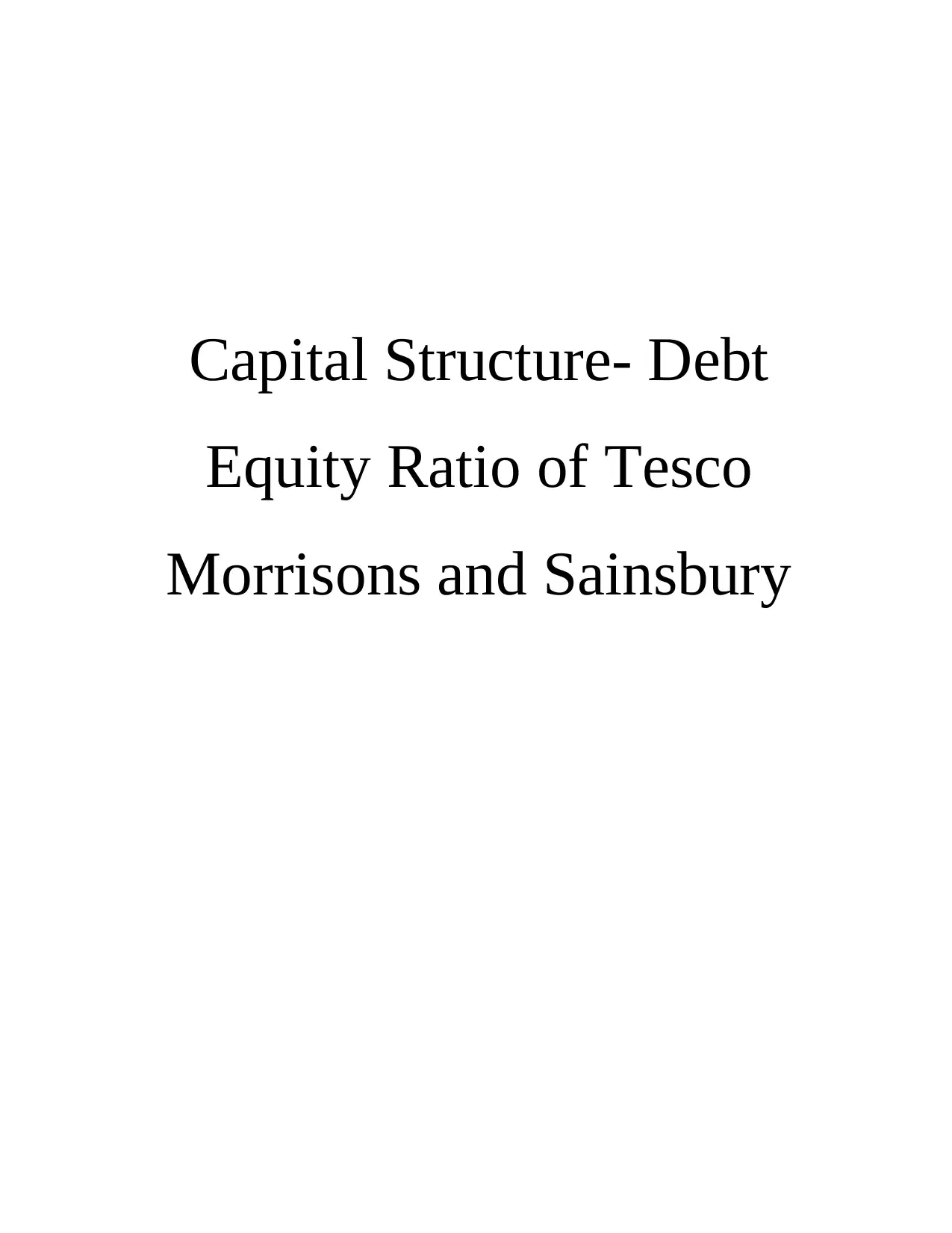
Capital Structure- Debt
Equity Ratio of Tesco
Morrisons and Sainsbury
Equity Ratio of Tesco
Morrisons and Sainsbury
Paraphrase This Document
Need a fresh take? Get an instant paraphrase of this document with our AI Paraphraser
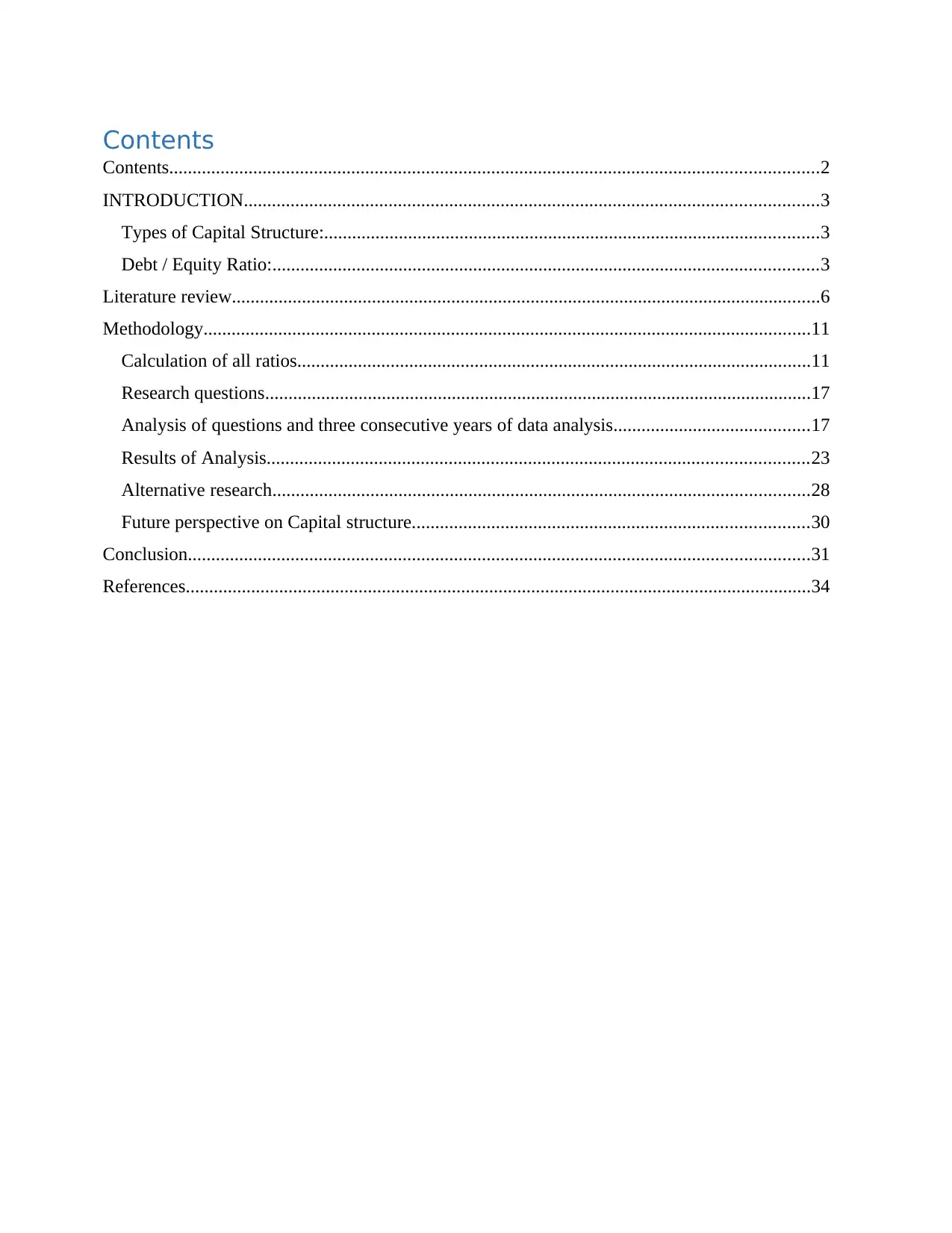
Contents
Contents...........................................................................................................................................2
INTRODUCTION...........................................................................................................................3
Types of Capital Structure:..........................................................................................................3
Debt / Equity Ratio:.....................................................................................................................3
Literature review..............................................................................................................................6
Methodology..................................................................................................................................11
Calculation of all ratios..............................................................................................................11
Research questions.....................................................................................................................17
Analysis of questions and three consecutive years of data analysis..........................................17
Results of Analysis....................................................................................................................23
Alternative research...................................................................................................................28
Future perspective on Capital structure.....................................................................................30
Conclusion.....................................................................................................................................31
References......................................................................................................................................34
Contents...........................................................................................................................................2
INTRODUCTION...........................................................................................................................3
Types of Capital Structure:..........................................................................................................3
Debt / Equity Ratio:.....................................................................................................................3
Literature review..............................................................................................................................6
Methodology..................................................................................................................................11
Calculation of all ratios..............................................................................................................11
Research questions.....................................................................................................................17
Analysis of questions and three consecutive years of data analysis..........................................17
Results of Analysis....................................................................................................................23
Alternative research...................................................................................................................28
Future perspective on Capital structure.....................................................................................30
Conclusion.....................................................................................................................................31
References......................................................................................................................................34
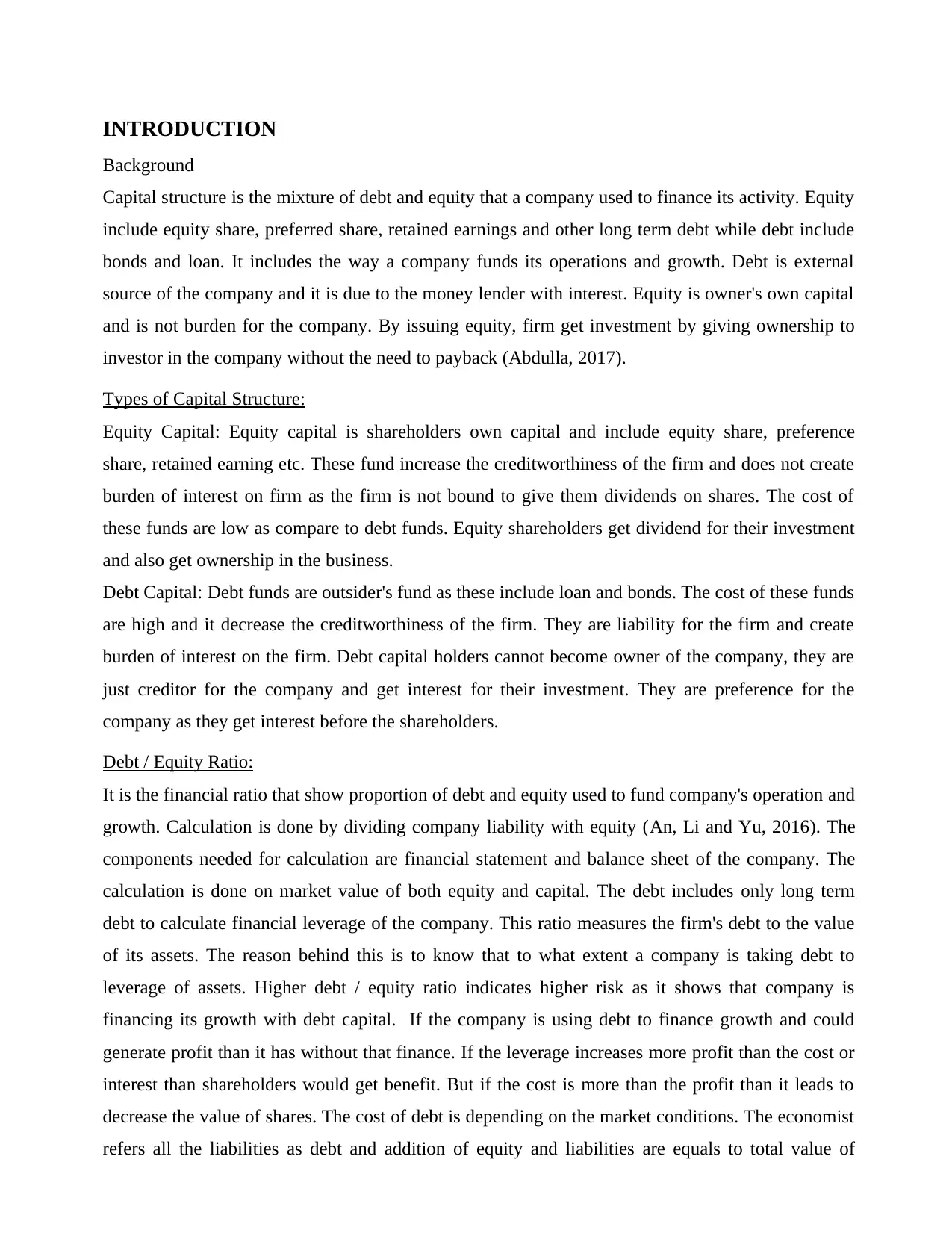
INTRODUCTION
Background
Capital structure is the mixture of debt and equity that a company used to finance its activity. Equity
include equity share, preferred share, retained earnings and other long term debt while debt include
bonds and loan. It includes the way a company funds its operations and growth. Debt is external
source of the company and it is due to the money lender with interest. Equity is owner's own capital
and is not burden for the company. By issuing equity, firm get investment by giving ownership to
investor in the company without the need to payback (Abdulla, 2017).
Types of Capital Structure:
Equity Capital: Equity capital is shareholders own capital and include equity share, preference
share, retained earning etc. These fund increase the creditworthiness of the firm and does not create
burden of interest on firm as the firm is not bound to give them dividends on shares. The cost of
these funds are low as compare to debt funds. Equity shareholders get dividend for their investment
and also get ownership in the business.
Debt Capital: Debt funds are outsider's fund as these include loan and bonds. The cost of these funds
are high and it decrease the creditworthiness of the firm. They are liability for the firm and create
burden of interest on the firm. Debt capital holders cannot become owner of the company, they are
just creditor for the company and get interest for their investment. They are preference for the
company as they get interest before the shareholders.
Debt / Equity Ratio:
It is the financial ratio that show proportion of debt and equity used to fund company's operation and
growth. Calculation is done by dividing company liability with equity (An, Li and Yu, 2016). The
components needed for calculation are financial statement and balance sheet of the company. The
calculation is done on market value of both equity and capital. The debt includes only long term
debt to calculate financial leverage of the company. This ratio measures the firm's debt to the value
of its assets. The reason behind this is to know that to what extent a company is taking debt to
leverage of assets. Higher debt / equity ratio indicates higher risk as it shows that company is
financing its growth with debt capital. If the company is using debt to finance growth and could
generate profit than it has without that finance. If the leverage increases more profit than the cost or
interest than shareholders would get benefit. But if the cost is more than the profit than it leads to
decrease the value of shares. The cost of debt is depending on the market conditions. The economist
refers all the liabilities as debt and addition of equity and liabilities are equals to total value of
Background
Capital structure is the mixture of debt and equity that a company used to finance its activity. Equity
include equity share, preferred share, retained earnings and other long term debt while debt include
bonds and loan. It includes the way a company funds its operations and growth. Debt is external
source of the company and it is due to the money lender with interest. Equity is owner's own capital
and is not burden for the company. By issuing equity, firm get investment by giving ownership to
investor in the company without the need to payback (Abdulla, 2017).
Types of Capital Structure:
Equity Capital: Equity capital is shareholders own capital and include equity share, preference
share, retained earning etc. These fund increase the creditworthiness of the firm and does not create
burden of interest on firm as the firm is not bound to give them dividends on shares. The cost of
these funds are low as compare to debt funds. Equity shareholders get dividend for their investment
and also get ownership in the business.
Debt Capital: Debt funds are outsider's fund as these include loan and bonds. The cost of these funds
are high and it decrease the creditworthiness of the firm. They are liability for the firm and create
burden of interest on the firm. Debt capital holders cannot become owner of the company, they are
just creditor for the company and get interest for their investment. They are preference for the
company as they get interest before the shareholders.
Debt / Equity Ratio:
It is the financial ratio that show proportion of debt and equity used to fund company's operation and
growth. Calculation is done by dividing company liability with equity (An, Li and Yu, 2016). The
components needed for calculation are financial statement and balance sheet of the company. The
calculation is done on market value of both equity and capital. The debt includes only long term
debt to calculate financial leverage of the company. This ratio measures the firm's debt to the value
of its assets. The reason behind this is to know that to what extent a company is taking debt to
leverage of assets. Higher debt / equity ratio indicates higher risk as it shows that company is
financing its growth with debt capital. If the company is using debt to finance growth and could
generate profit than it has without that finance. If the leverage increases more profit than the cost or
interest than shareholders would get benefit. But if the cost is more than the profit than it leads to
decrease the value of shares. The cost of debt is depending on the market conditions. The economist
refers all the liabilities as debt and addition of equity and liabilities are equals to total value of
⊘ This is a preview!⊘
Do you want full access?
Subscribe today to unlock all pages.

Trusted by 1+ million students worldwide
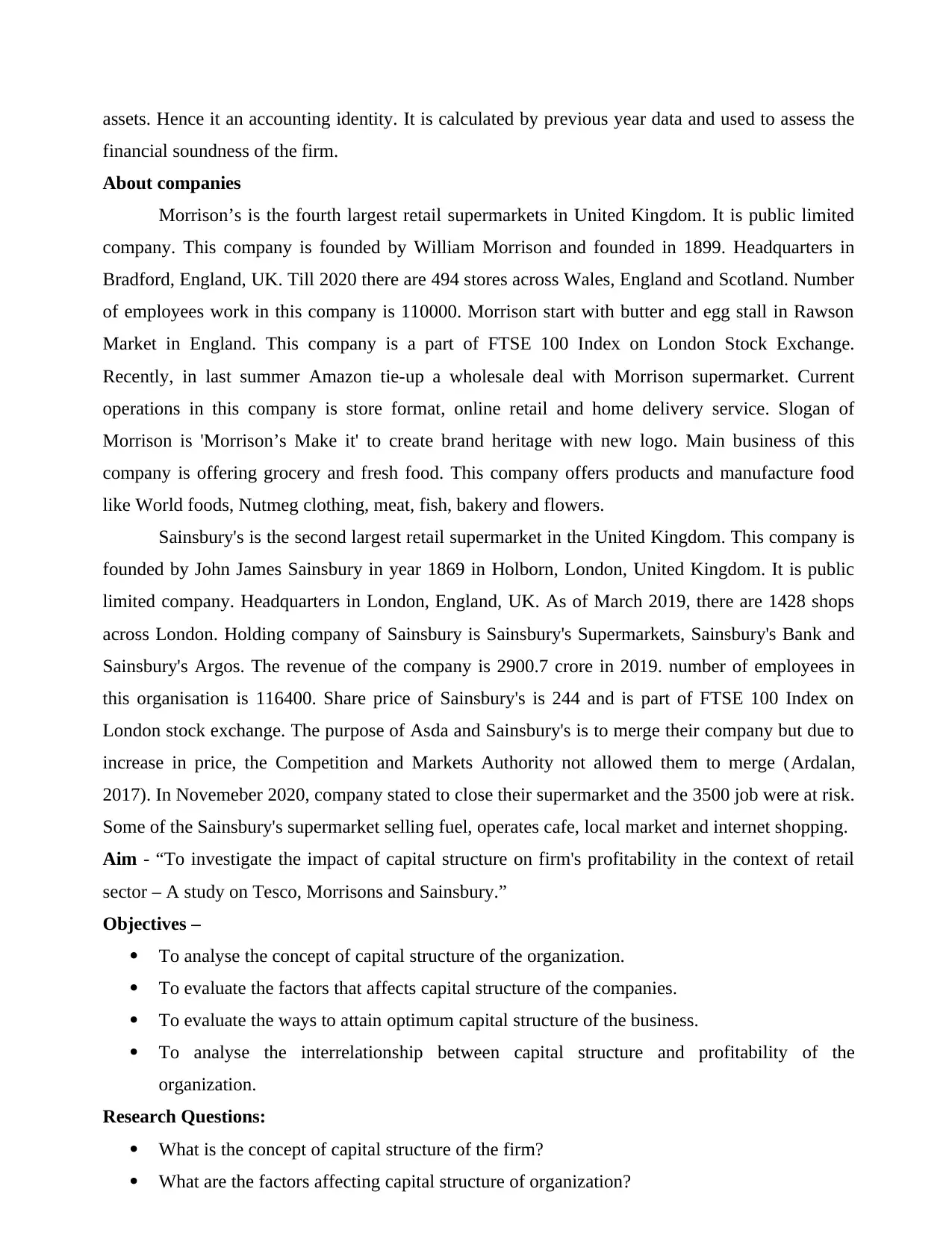
assets. Hence it an accounting identity. It is calculated by previous year data and used to assess the
financial soundness of the firm.
About companies
Morrison’s is the fourth largest retail supermarkets in United Kingdom. It is public limited
company. This company is founded by William Morrison and founded in 1899. Headquarters in
Bradford, England, UK. Till 2020 there are 494 stores across Wales, England and Scotland. Number
of employees work in this company is 110000. Morrison start with butter and egg stall in Rawson
Market in England. This company is a part of FTSE 100 Index on London Stock Exchange.
Recently, in last summer Amazon tie-up a wholesale deal with Morrison supermarket. Current
operations in this company is store format, online retail and home delivery service. Slogan of
Morrison is 'Morrison’s Make it' to create brand heritage with new logo. Main business of this
company is offering grocery and fresh food. This company offers products and manufacture food
like World foods, Nutmeg clothing, meat, fish, bakery and flowers.
Sainsbury's is the second largest retail supermarket in the United Kingdom. This company is
founded by John James Sainsbury in year 1869 in Holborn, London, United Kingdom. It is public
limited company. Headquarters in London, England, UK. As of March 2019, there are 1428 shops
across London. Holding company of Sainsbury is Sainsbury's Supermarkets, Sainsbury's Bank and
Sainsbury's Argos. The revenue of the company is 2900.7 crore in 2019. number of employees in
this organisation is 116400. Share price of Sainsbury's is 244 and is part of FTSE 100 Index on
London stock exchange. The purpose of Asda and Sainsbury's is to merge their company but due to
increase in price, the Competition and Markets Authority not allowed them to merge (Ardalan,
2017). In Novemeber 2020, company stated to close their supermarket and the 3500 job were at risk.
Some of the Sainsbury's supermarket selling fuel, operates cafe, local market and internet shopping.
Aim - “To investigate the impact of capital structure on firm's profitability in the context of retail
sector – A study on Tesco, Morrisons and Sainsbury.”
Objectives –
To analyse the concept of capital structure of the organization.
To evaluate the factors that affects capital structure of the companies.
To evaluate the ways to attain optimum capital structure of the business.
To analyse the interrelationship between capital structure and profitability of the
organization.
Research Questions:
What is the concept of capital structure of the firm?
What are the factors affecting capital structure of organization?
financial soundness of the firm.
About companies
Morrison’s is the fourth largest retail supermarkets in United Kingdom. It is public limited
company. This company is founded by William Morrison and founded in 1899. Headquarters in
Bradford, England, UK. Till 2020 there are 494 stores across Wales, England and Scotland. Number
of employees work in this company is 110000. Morrison start with butter and egg stall in Rawson
Market in England. This company is a part of FTSE 100 Index on London Stock Exchange.
Recently, in last summer Amazon tie-up a wholesale deal with Morrison supermarket. Current
operations in this company is store format, online retail and home delivery service. Slogan of
Morrison is 'Morrison’s Make it' to create brand heritage with new logo. Main business of this
company is offering grocery and fresh food. This company offers products and manufacture food
like World foods, Nutmeg clothing, meat, fish, bakery and flowers.
Sainsbury's is the second largest retail supermarket in the United Kingdom. This company is
founded by John James Sainsbury in year 1869 in Holborn, London, United Kingdom. It is public
limited company. Headquarters in London, England, UK. As of March 2019, there are 1428 shops
across London. Holding company of Sainsbury is Sainsbury's Supermarkets, Sainsbury's Bank and
Sainsbury's Argos. The revenue of the company is 2900.7 crore in 2019. number of employees in
this organisation is 116400. Share price of Sainsbury's is 244 and is part of FTSE 100 Index on
London stock exchange. The purpose of Asda and Sainsbury's is to merge their company but due to
increase in price, the Competition and Markets Authority not allowed them to merge (Ardalan,
2017). In Novemeber 2020, company stated to close their supermarket and the 3500 job were at risk.
Some of the Sainsbury's supermarket selling fuel, operates cafe, local market and internet shopping.
Aim - “To investigate the impact of capital structure on firm's profitability in the context of retail
sector – A study on Tesco, Morrisons and Sainsbury.”
Objectives –
To analyse the concept of capital structure of the organization.
To evaluate the factors that affects capital structure of the companies.
To evaluate the ways to attain optimum capital structure of the business.
To analyse the interrelationship between capital structure and profitability of the
organization.
Research Questions:
What is the concept of capital structure of the firm?
What are the factors affecting capital structure of organization?
Paraphrase This Document
Need a fresh take? Get an instant paraphrase of this document with our AI Paraphraser
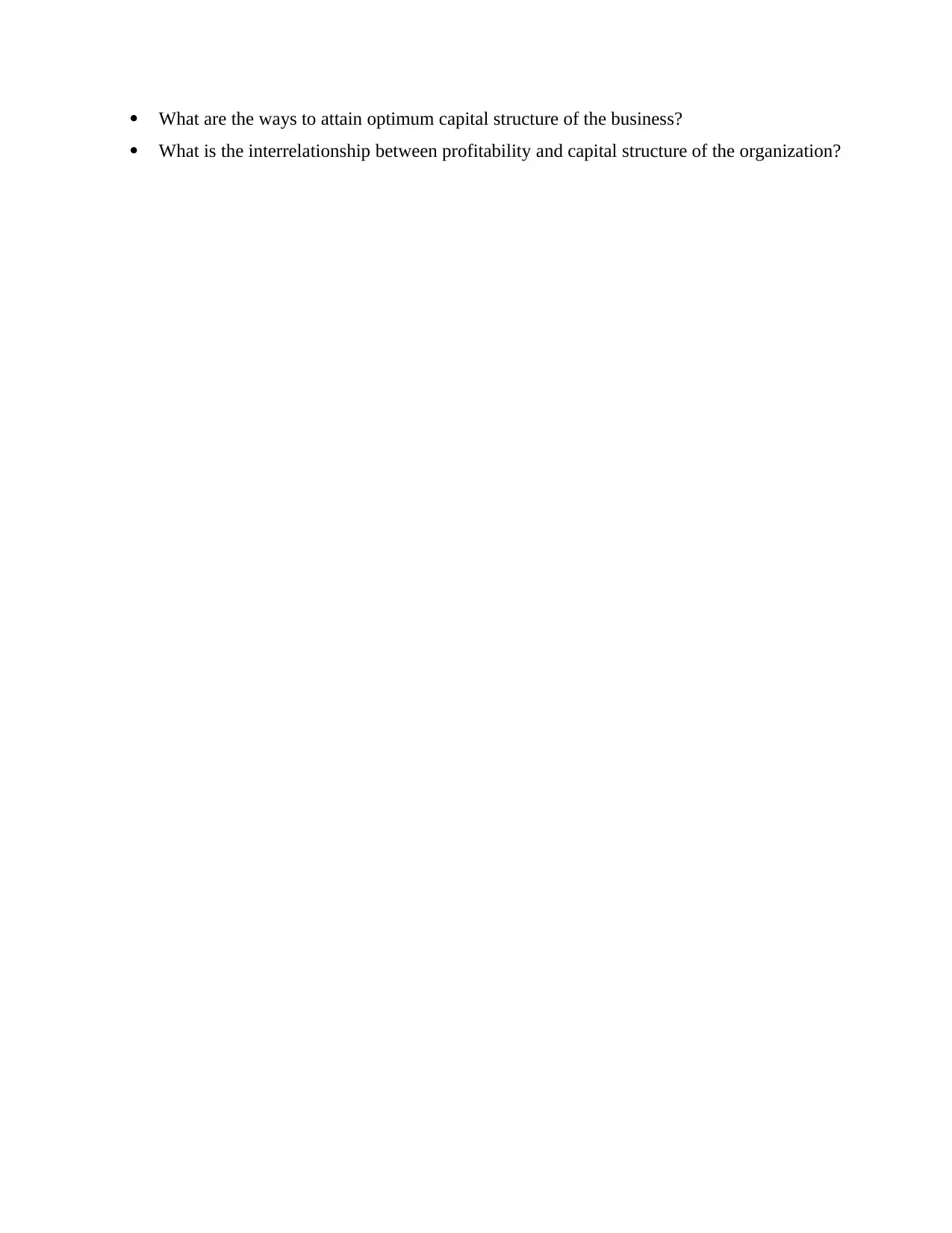
What are the ways to attain optimum capital structure of the business?
What is the interrelationship between profitability and capital structure of the organization?
What is the interrelationship between profitability and capital structure of the organization?
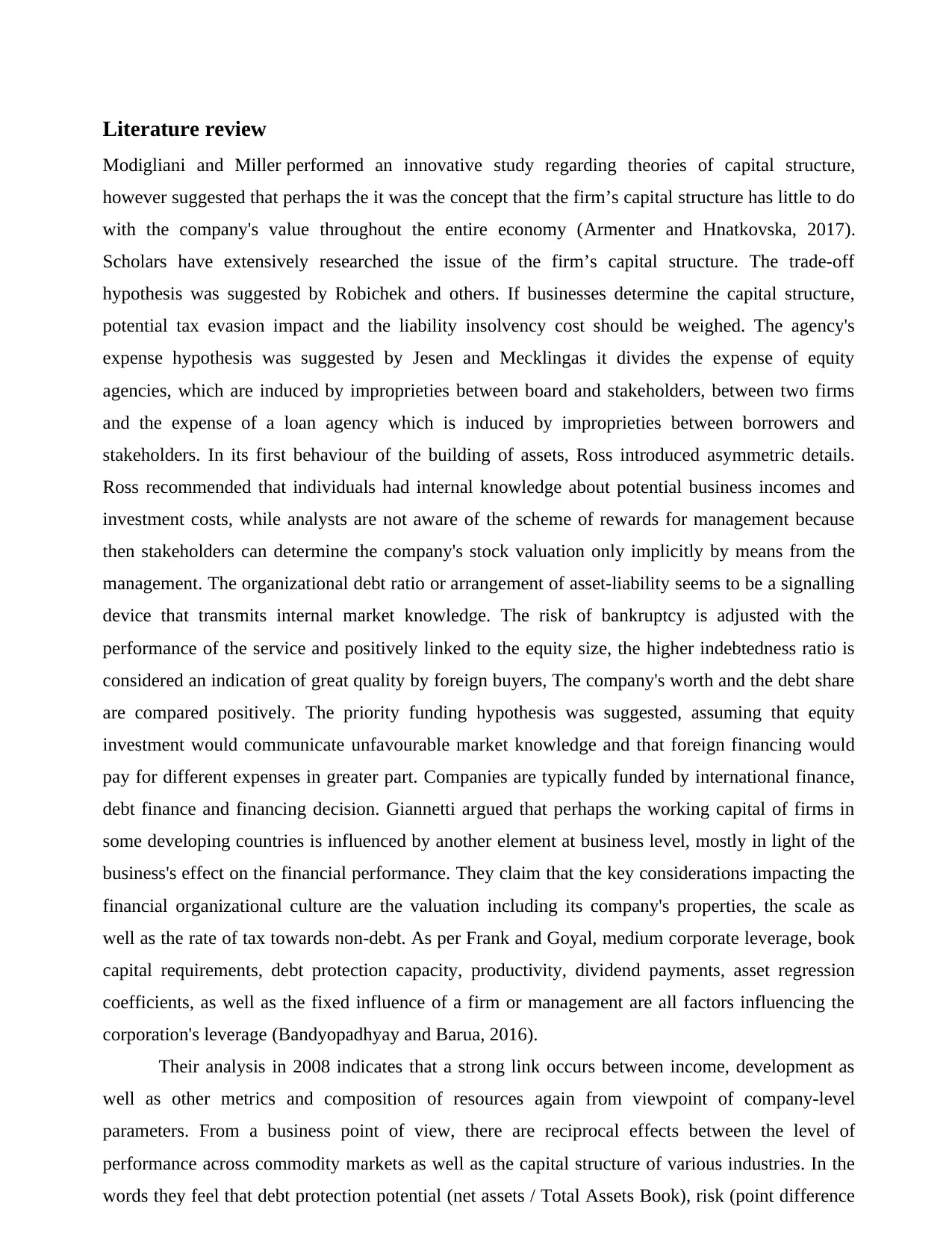
Literature review
Modigliani and Miller performed an innovative study regarding theories of capital structure,
however suggested that perhaps the it was the concept that the firm’s capital structure has little to do
with the company's value throughout the entire economy (Armenter and Hnatkovska, 2017).
Scholars have extensively researched the issue of the firm’s capital structure. The trade-off
hypothesis was suggested by Robichek and others. If businesses determine the capital structure,
potential tax evasion impact and the liability insolvency cost should be weighed. The agency's
expense hypothesis was suggested by Jesen and Mecklingas it divides the expense of equity
agencies, which are induced by improprieties between board and stakeholders, between two firms
and the expense of a loan agency which is induced by improprieties between borrowers and
stakeholders. In its first behaviour of the building of assets, Ross introduced asymmetric details.
Ross recommended that individuals had internal knowledge about potential business incomes and
investment costs, while analysts are not aware of the scheme of rewards for management because
then stakeholders can determine the company's stock valuation only implicitly by means from the
management. The organizational debt ratio or arrangement of asset-liability seems to be a signalling
device that transmits internal market knowledge. The risk of bankruptcy is adjusted with the
performance of the service and positively linked to the equity size, the higher indebtedness ratio is
considered an indication of great quality by foreign buyers, The company's worth and the debt share
are compared positively. The priority funding hypothesis was suggested, assuming that equity
investment would communicate unfavourable market knowledge and that foreign financing would
pay for different expenses in greater part. Companies are typically funded by international finance,
debt finance and financing decision. Giannetti argued that perhaps the working capital of firms in
some developing countries is influenced by another element at business level, mostly in light of the
business's effect on the financial performance. They claim that the key considerations impacting the
financial organizational culture are the valuation including its company's properties, the scale as
well as the rate of tax towards non-debt. As per Frank and Goyal, medium corporate leverage, book
capital requirements, debt protection capacity, productivity, dividend payments, asset regression
coefficients, as well as the fixed influence of a firm or management are all factors influencing the
corporation's leverage (Bandyopadhyay and Barua, 2016).
Their analysis in 2008 indicates that a strong link occurs between income, development as
well as other metrics and composition of resources again from viewpoint of company-level
parameters. From a business point of view, there are reciprocal effects between the level of
performance across commodity markets as well as the capital structure of various industries. In the
words they feel that debt protection potential (net assets / Total Assets Book), risk (point difference
Modigliani and Miller performed an innovative study regarding theories of capital structure,
however suggested that perhaps the it was the concept that the firm’s capital structure has little to do
with the company's value throughout the entire economy (Armenter and Hnatkovska, 2017).
Scholars have extensively researched the issue of the firm’s capital structure. The trade-off
hypothesis was suggested by Robichek and others. If businesses determine the capital structure,
potential tax evasion impact and the liability insolvency cost should be weighed. The agency's
expense hypothesis was suggested by Jesen and Mecklingas it divides the expense of equity
agencies, which are induced by improprieties between board and stakeholders, between two firms
and the expense of a loan agency which is induced by improprieties between borrowers and
stakeholders. In its first behaviour of the building of assets, Ross introduced asymmetric details.
Ross recommended that individuals had internal knowledge about potential business incomes and
investment costs, while analysts are not aware of the scheme of rewards for management because
then stakeholders can determine the company's stock valuation only implicitly by means from the
management. The organizational debt ratio or arrangement of asset-liability seems to be a signalling
device that transmits internal market knowledge. The risk of bankruptcy is adjusted with the
performance of the service and positively linked to the equity size, the higher indebtedness ratio is
considered an indication of great quality by foreign buyers, The company's worth and the debt share
are compared positively. The priority funding hypothesis was suggested, assuming that equity
investment would communicate unfavourable market knowledge and that foreign financing would
pay for different expenses in greater part. Companies are typically funded by international finance,
debt finance and financing decision. Giannetti argued that perhaps the working capital of firms in
some developing countries is influenced by another element at business level, mostly in light of the
business's effect on the financial performance. They claim that the key considerations impacting the
financial organizational culture are the valuation including its company's properties, the scale as
well as the rate of tax towards non-debt. As per Frank and Goyal, medium corporate leverage, book
capital requirements, debt protection capacity, productivity, dividend payments, asset regression
coefficients, as well as the fixed influence of a firm or management are all factors influencing the
corporation's leverage (Bandyopadhyay and Barua, 2016).
Their analysis in 2008 indicates that a strong link occurs between income, development as
well as other metrics and composition of resources again from viewpoint of company-level
parameters. From a business point of view, there are reciprocal effects between the level of
performance across commodity markets as well as the capital structure of various industries. In the
words they feel that debt protection potential (net assets / Total Assets Book), risk (point difference
⊘ This is a preview!⊘
Do you want full access?
Subscribe today to unlock all pages.

Trusted by 1+ million students worldwide
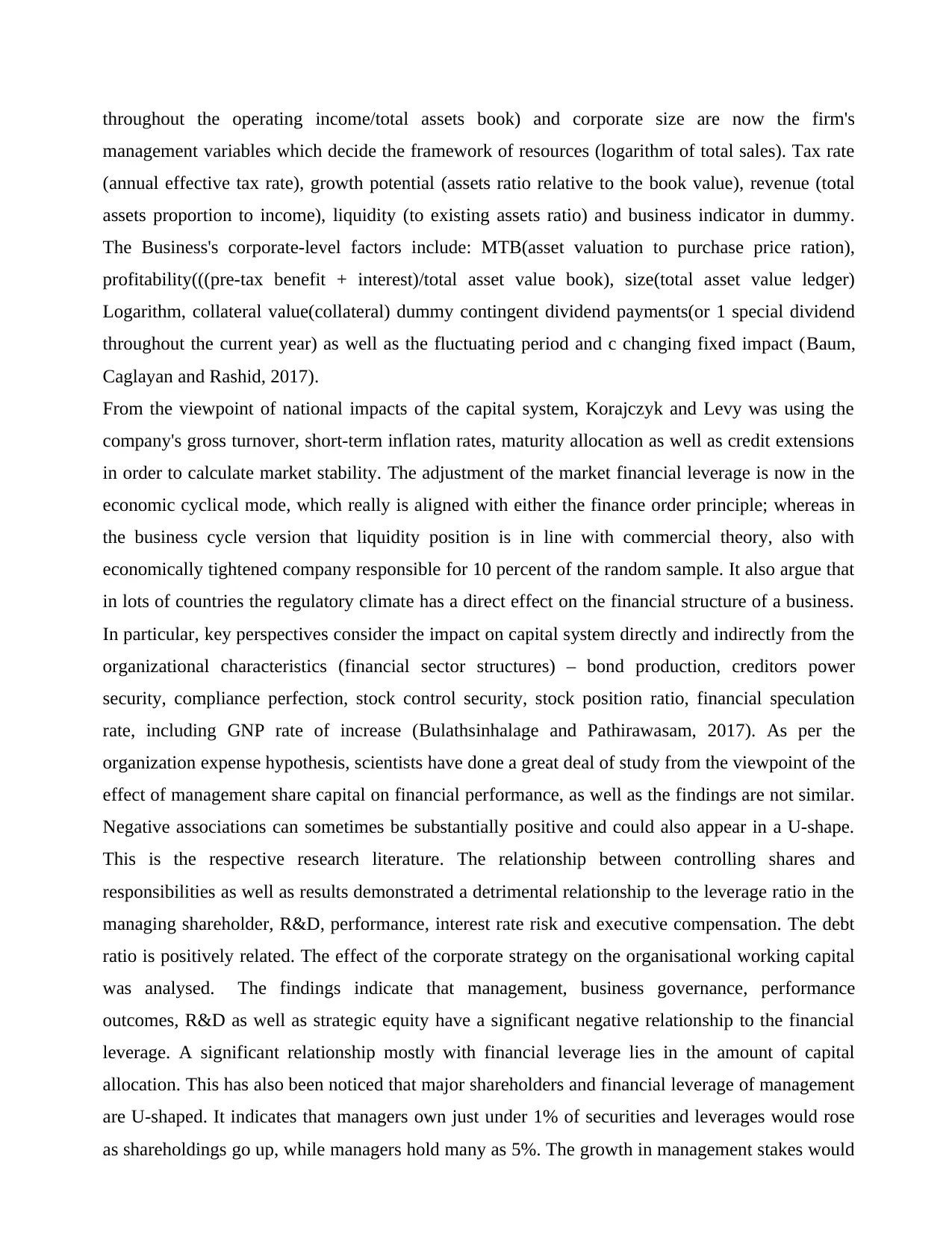
throughout the operating income/total assets book) and corporate size are now the firm's
management variables which decide the framework of resources (logarithm of total sales). Tax rate
(annual effective tax rate), growth potential (assets ratio relative to the book value), revenue (total
assets proportion to income), liquidity (to existing assets ratio) and business indicator in dummy.
The Business's corporate-level factors include: MTB(asset valuation to purchase price ration),
profitability(((pre-tax benefit + interest)/total asset value book), size(total asset value ledger)
Logarithm, collateral value(collateral) dummy contingent dividend payments(or 1 special dividend
throughout the current year) as well as the fluctuating period and c changing fixed impact (Baum,
Caglayan and Rashid, 2017).
From the viewpoint of national impacts of the capital system, Korajczyk and Levy was using the
company's gross turnover, short-term inflation rates, maturity allocation as well as credit extensions
in order to calculate market stability. The adjustment of the market financial leverage is now in the
economic cyclical mode, which really is aligned with either the finance order principle; whereas in
the business cycle version that liquidity position is in line with commercial theory, also with
economically tightened company responsible for 10 percent of the random sample. It also argue that
in lots of countries the regulatory climate has a direct effect on the financial structure of a business.
In particular, key perspectives consider the impact on capital system directly and indirectly from the
organizational characteristics (financial sector structures) – bond production, creditors power
security, compliance perfection, stock control security, stock position ratio, financial speculation
rate, including GNP rate of increase (Bulathsinhalage and Pathirawasam, 2017). As per the
organization expense hypothesis, scientists have done a great deal of study from the viewpoint of the
effect of management share capital on financial performance, as well as the findings are not similar.
Negative associations can sometimes be substantially positive and could also appear in a U-shape.
This is the respective research literature. The relationship between controlling shares and
responsibilities as well as results demonstrated a detrimental relationship to the leverage ratio in the
managing shareholder, R&D, performance, interest rate risk and executive compensation. The debt
ratio is positively related. The effect of the corporate strategy on the organisational working capital
was analysed. The findings indicate that management, business governance, performance
outcomes, R&D as well as strategic equity have a significant negative relationship to the financial
leverage. A significant relationship mostly with financial leverage lies in the amount of capital
allocation. This has also been noticed that major shareholders and financial leverage of management
are U-shaped. It indicates that managers own just under 1% of securities and leverages would rose
as shareholdings go up, while managers hold many as 5%. The growth in management stakes would
management variables which decide the framework of resources (logarithm of total sales). Tax rate
(annual effective tax rate), growth potential (assets ratio relative to the book value), revenue (total
assets proportion to income), liquidity (to existing assets ratio) and business indicator in dummy.
The Business's corporate-level factors include: MTB(asset valuation to purchase price ration),
profitability(((pre-tax benefit + interest)/total asset value book), size(total asset value ledger)
Logarithm, collateral value(collateral) dummy contingent dividend payments(or 1 special dividend
throughout the current year) as well as the fluctuating period and c changing fixed impact (Baum,
Caglayan and Rashid, 2017).
From the viewpoint of national impacts of the capital system, Korajczyk and Levy was using the
company's gross turnover, short-term inflation rates, maturity allocation as well as credit extensions
in order to calculate market stability. The adjustment of the market financial leverage is now in the
economic cyclical mode, which really is aligned with either the finance order principle; whereas in
the business cycle version that liquidity position is in line with commercial theory, also with
economically tightened company responsible for 10 percent of the random sample. It also argue that
in lots of countries the regulatory climate has a direct effect on the financial structure of a business.
In particular, key perspectives consider the impact on capital system directly and indirectly from the
organizational characteristics (financial sector structures) – bond production, creditors power
security, compliance perfection, stock control security, stock position ratio, financial speculation
rate, including GNP rate of increase (Bulathsinhalage and Pathirawasam, 2017). As per the
organization expense hypothesis, scientists have done a great deal of study from the viewpoint of the
effect of management share capital on financial performance, as well as the findings are not similar.
Negative associations can sometimes be substantially positive and could also appear in a U-shape.
This is the respective research literature. The relationship between controlling shares and
responsibilities as well as results demonstrated a detrimental relationship to the leverage ratio in the
managing shareholder, R&D, performance, interest rate risk and executive compensation. The debt
ratio is positively related. The effect of the corporate strategy on the organisational working capital
was analysed. The findings indicate that management, business governance, performance
outcomes, R&D as well as strategic equity have a significant negative relationship to the financial
leverage. A significant relationship mostly with financial leverage lies in the amount of capital
allocation. This has also been noticed that major shareholders and financial leverage of management
are U-shaped. It indicates that managers own just under 1% of securities and leverages would rose
as shareholdings go up, while managers hold many as 5%. The growth in management stakes would
Paraphrase This Document
Need a fresh take? Get an instant paraphrase of this document with our AI Paraphraser
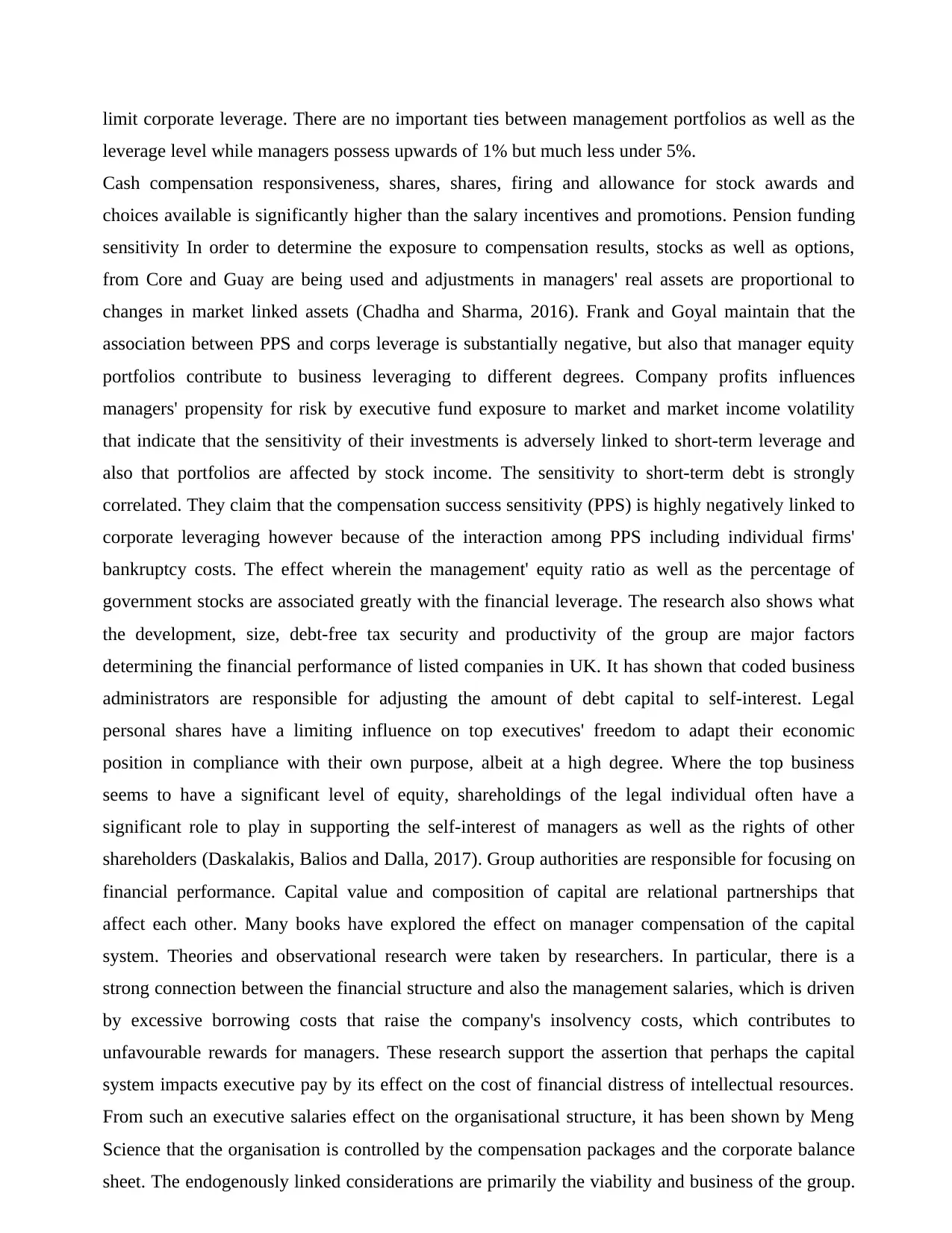
limit corporate leverage. There are no important ties between management portfolios as well as the
leverage level while managers possess upwards of 1% but much less under 5%.
Cash compensation responsiveness, shares, shares, firing and allowance for stock awards and
choices available is significantly higher than the salary incentives and promotions. Pension funding
sensitivity In order to determine the exposure to compensation results, stocks as well as options,
from Core and Guay are being used and adjustments in managers' real assets are proportional to
changes in market linked assets (Chadha and Sharma, 2016). Frank and Goyal maintain that the
association between PPS and corps leverage is substantially negative, but also that manager equity
portfolios contribute to business leveraging to different degrees. Company profits influences
managers' propensity for risk by executive fund exposure to market and market income volatility
that indicate that the sensitivity of their investments is adversely linked to short-term leverage and
also that portfolios are affected by stock income. The sensitivity to short-term debt is strongly
correlated. They claim that the compensation success sensitivity (PPS) is highly negatively linked to
corporate leveraging however because of the interaction among PPS including individual firms'
bankruptcy costs. The effect wherein the management' equity ratio as well as the percentage of
government stocks are associated greatly with the financial leverage. The research also shows what
the development, size, debt-free tax security and productivity of the group are major factors
determining the financial performance of listed companies in UK. It has shown that coded business
administrators are responsible for adjusting the amount of debt capital to self-interest. Legal
personal shares have a limiting influence on top executives' freedom to adapt their economic
position in compliance with their own purpose, albeit at a high degree. Where the top business
seems to have a significant level of equity, shareholdings of the legal individual often have a
significant role to play in supporting the self-interest of managers as well as the rights of other
shareholders (Daskalakis, Balios and Dalla, 2017). Group authorities are responsible for focusing on
financial performance. Capital value and composition of capital are relational partnerships that
affect each other. Many books have explored the effect on manager compensation of the capital
system. Theories and observational research were taken by researchers. In particular, there is a
strong connection between the financial structure and also the management salaries, which is driven
by excessive borrowing costs that raise the company's insolvency costs, which contributes to
unfavourable rewards for managers. These research support the assertion that perhaps the capital
system impacts executive pay by its effect on the cost of financial distress of intellectual resources.
From such an executive salaries effect on the organisational structure, it has been shown by Meng
Science that the organisation is controlled by the compensation packages and the corporate balance
sheet. The endogenously linked considerations are primarily the viability and business of the group.
leverage level while managers possess upwards of 1% but much less under 5%.
Cash compensation responsiveness, shares, shares, firing and allowance for stock awards and
choices available is significantly higher than the salary incentives and promotions. Pension funding
sensitivity In order to determine the exposure to compensation results, stocks as well as options,
from Core and Guay are being used and adjustments in managers' real assets are proportional to
changes in market linked assets (Chadha and Sharma, 2016). Frank and Goyal maintain that the
association between PPS and corps leverage is substantially negative, but also that manager equity
portfolios contribute to business leveraging to different degrees. Company profits influences
managers' propensity for risk by executive fund exposure to market and market income volatility
that indicate that the sensitivity of their investments is adversely linked to short-term leverage and
also that portfolios are affected by stock income. The sensitivity to short-term debt is strongly
correlated. They claim that the compensation success sensitivity (PPS) is highly negatively linked to
corporate leveraging however because of the interaction among PPS including individual firms'
bankruptcy costs. The effect wherein the management' equity ratio as well as the percentage of
government stocks are associated greatly with the financial leverage. The research also shows what
the development, size, debt-free tax security and productivity of the group are major factors
determining the financial performance of listed companies in UK. It has shown that coded business
administrators are responsible for adjusting the amount of debt capital to self-interest. Legal
personal shares have a limiting influence on top executives' freedom to adapt their economic
position in compliance with their own purpose, albeit at a high degree. Where the top business
seems to have a significant level of equity, shareholdings of the legal individual often have a
significant role to play in supporting the self-interest of managers as well as the rights of other
shareholders (Daskalakis, Balios and Dalla, 2017). Group authorities are responsible for focusing on
financial performance. Capital value and composition of capital are relational partnerships that
affect each other. Many books have explored the effect on manager compensation of the capital
system. Theories and observational research were taken by researchers. In particular, there is a
strong connection between the financial structure and also the management salaries, which is driven
by excessive borrowing costs that raise the company's insolvency costs, which contributes to
unfavourable rewards for managers. These research support the assertion that perhaps the capital
system impacts executive pay by its effect on the cost of financial distress of intellectual resources.
From such an executive salaries effect on the organisational structure, it has been shown by Meng
Science that the organisation is controlled by the compensation packages and the corporate balance
sheet. The endogenously linked considerations are primarily the viability and business of the group.
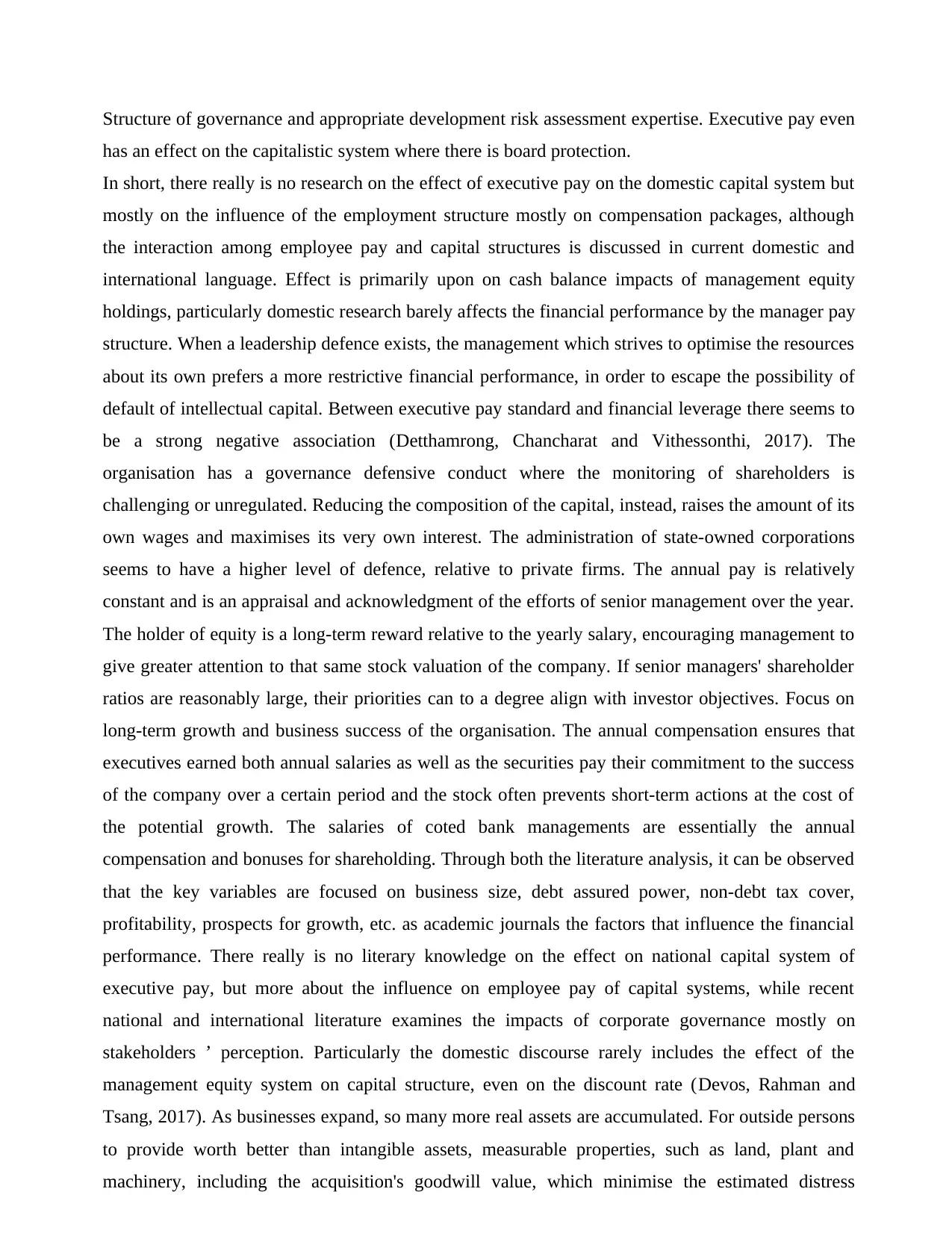
Structure of governance and appropriate development risk assessment expertise. Executive pay even
has an effect on the capitalistic system where there is board protection.
In short, there really is no research on the effect of executive pay on the domestic capital system but
mostly on the influence of the employment structure mostly on compensation packages, although
the interaction among employee pay and capital structures is discussed in current domestic and
international language. Effect is primarily upon on cash balance impacts of management equity
holdings, particularly domestic research barely affects the financial performance by the manager pay
structure. When a leadership defence exists, the management which strives to optimise the resources
about its own prefers a more restrictive financial performance, in order to escape the possibility of
default of intellectual capital. Between executive pay standard and financial leverage there seems to
be a strong negative association (Detthamrong, Chancharat and Vithessonthi, 2017). The
organisation has a governance defensive conduct where the monitoring of shareholders is
challenging or unregulated. Reducing the composition of the capital, instead, raises the amount of its
own wages and maximises its very own interest. The administration of state-owned corporations
seems to have a higher level of defence, relative to private firms. The annual pay is relatively
constant and is an appraisal and acknowledgment of the efforts of senior management over the year.
The holder of equity is a long-term reward relative to the yearly salary, encouraging management to
give greater attention to that same stock valuation of the company. If senior managers' shareholder
ratios are reasonably large, their priorities can to a degree align with investor objectives. Focus on
long-term growth and business success of the organisation. The annual compensation ensures that
executives earned both annual salaries as well as the securities pay their commitment to the success
of the company over a certain period and the stock often prevents short-term actions at the cost of
the potential growth. The salaries of coted bank managements are essentially the annual
compensation and bonuses for shareholding. Through both the literature analysis, it can be observed
that the key variables are focused on business size, debt assured power, non-debt tax cover,
profitability, prospects for growth, etc. as academic journals the factors that influence the financial
performance. There really is no literary knowledge on the effect on national capital system of
executive pay, but more about the influence on employee pay of capital systems, while recent
national and international literature examines the impacts of corporate governance mostly on
stakeholders ’ perception. Particularly the domestic discourse rarely includes the effect of the
management equity system on capital structure, even on the discount rate (Devos, Rahman and
Tsang, 2017). As businesses expand, so many more real assets are accumulated. For outside persons
to provide worth better than intangible assets, measurable properties, such as land, plant and
machinery, including the acquisition's goodwill value, which minimise the estimated distress
has an effect on the capitalistic system where there is board protection.
In short, there really is no research on the effect of executive pay on the domestic capital system but
mostly on the influence of the employment structure mostly on compensation packages, although
the interaction among employee pay and capital structures is discussed in current domestic and
international language. Effect is primarily upon on cash balance impacts of management equity
holdings, particularly domestic research barely affects the financial performance by the manager pay
structure. When a leadership defence exists, the management which strives to optimise the resources
about its own prefers a more restrictive financial performance, in order to escape the possibility of
default of intellectual capital. Between executive pay standard and financial leverage there seems to
be a strong negative association (Detthamrong, Chancharat and Vithessonthi, 2017). The
organisation has a governance defensive conduct where the monitoring of shareholders is
challenging or unregulated. Reducing the composition of the capital, instead, raises the amount of its
own wages and maximises its very own interest. The administration of state-owned corporations
seems to have a higher level of defence, relative to private firms. The annual pay is relatively
constant and is an appraisal and acknowledgment of the efforts of senior management over the year.
The holder of equity is a long-term reward relative to the yearly salary, encouraging management to
give greater attention to that same stock valuation of the company. If senior managers' shareholder
ratios are reasonably large, their priorities can to a degree align with investor objectives. Focus on
long-term growth and business success of the organisation. The annual compensation ensures that
executives earned both annual salaries as well as the securities pay their commitment to the success
of the company over a certain period and the stock often prevents short-term actions at the cost of
the potential growth. The salaries of coted bank managements are essentially the annual
compensation and bonuses for shareholding. Through both the literature analysis, it can be observed
that the key variables are focused on business size, debt assured power, non-debt tax cover,
profitability, prospects for growth, etc. as academic journals the factors that influence the financial
performance. There really is no literary knowledge on the effect on national capital system of
executive pay, but more about the influence on employee pay of capital systems, while recent
national and international literature examines the impacts of corporate governance mostly on
stakeholders ’ perception. Particularly the domestic discourse rarely includes the effect of the
management equity system on capital structure, even on the discount rate (Devos, Rahman and
Tsang, 2017). As businesses expand, so many more real assets are accumulated. For outside persons
to provide worth better than intangible assets, measurable properties, such as land, plant and
machinery, including the acquisition's goodwill value, which minimise the estimated distress
⊘ This is a preview!⊘
Do you want full access?
Subscribe today to unlock all pages.

Trusted by 1+ million students worldwide
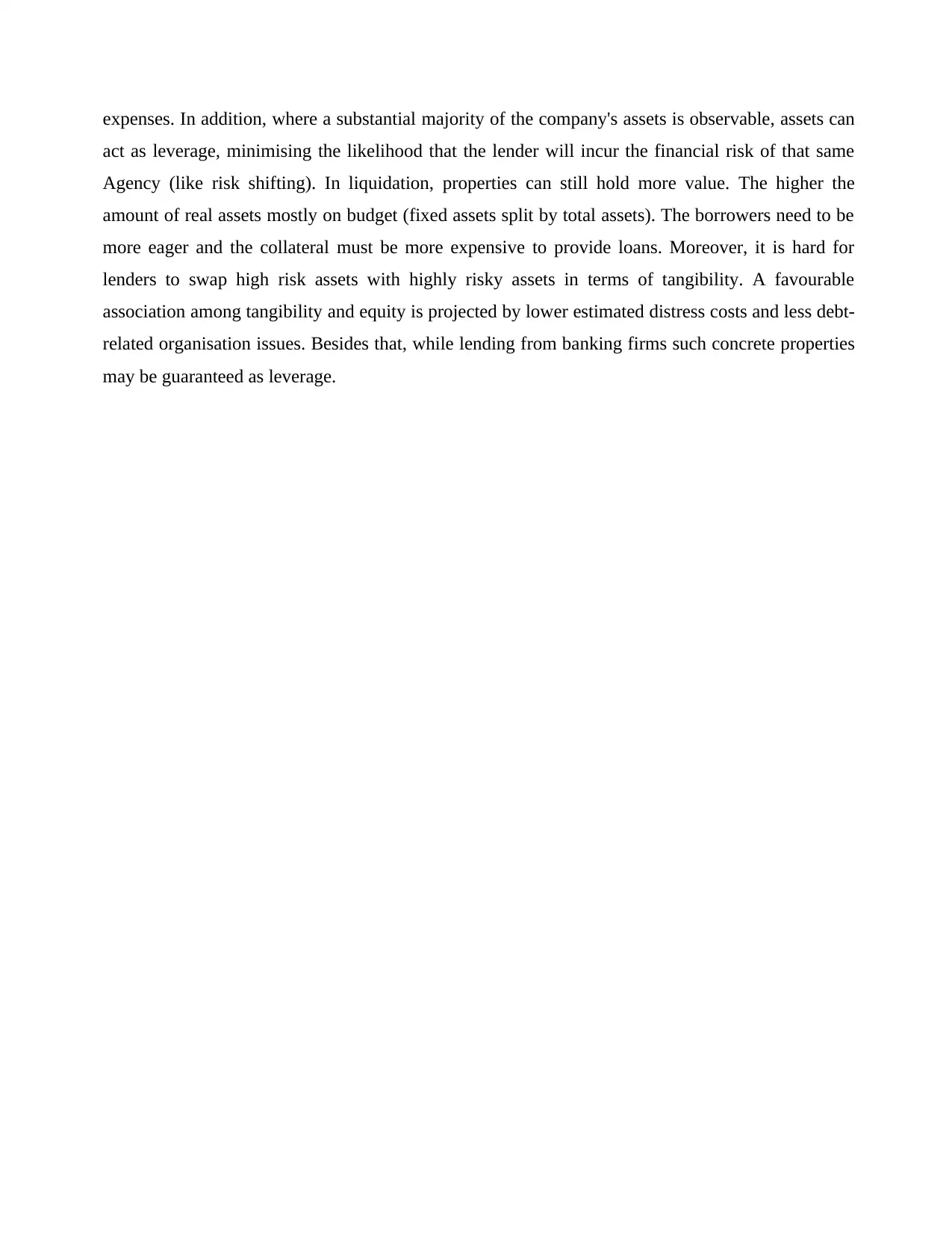
expenses. In addition, where a substantial majority of the company's assets is observable, assets can
act as leverage, minimising the likelihood that the lender will incur the financial risk of that same
Agency (like risk shifting). In liquidation, properties can still hold more value. The higher the
amount of real assets mostly on budget (fixed assets split by total assets). The borrowers need to be
more eager and the collateral must be more expensive to provide loans. Moreover, it is hard for
lenders to swap high risk assets with highly risky assets in terms of tangibility. A favourable
association among tangibility and equity is projected by lower estimated distress costs and less debt-
related organisation issues. Besides that, while lending from banking firms such concrete properties
may be guaranteed as leverage.
act as leverage, minimising the likelihood that the lender will incur the financial risk of that same
Agency (like risk shifting). In liquidation, properties can still hold more value. The higher the
amount of real assets mostly on budget (fixed assets split by total assets). The borrowers need to be
more eager and the collateral must be more expensive to provide loans. Moreover, it is hard for
lenders to swap high risk assets with highly risky assets in terms of tangibility. A favourable
association among tangibility and equity is projected by lower estimated distress costs and less debt-
related organisation issues. Besides that, while lending from banking firms such concrete properties
may be guaranteed as leverage.
Paraphrase This Document
Need a fresh take? Get an instant paraphrase of this document with our AI Paraphraser
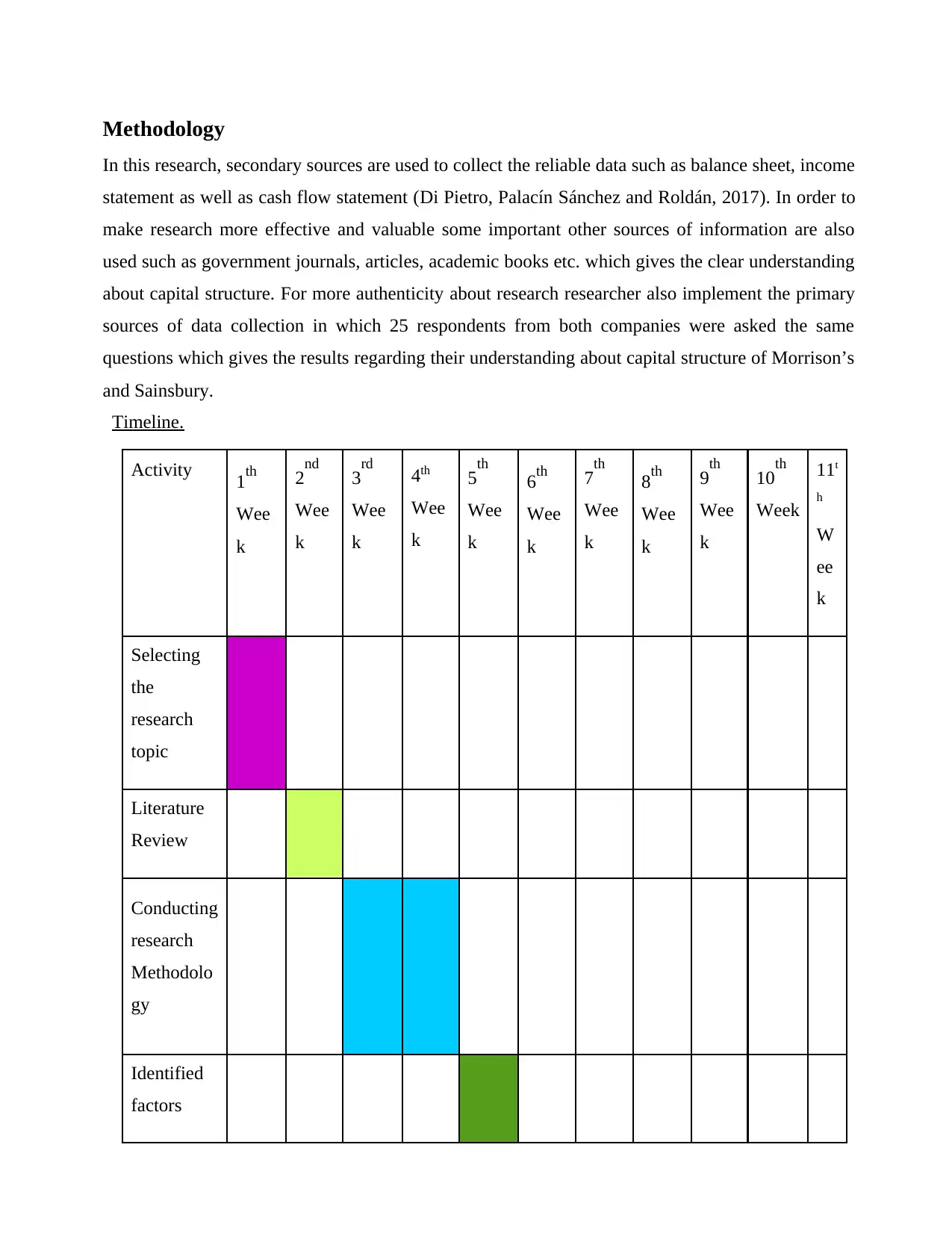
Methodology
In this research, secondary sources are used to collect the reliable data such as balance sheet, income
statement as well as cash flow statement (Di Pietro, Palacín Sánchez and Roldán, 2017). In order to
make research more effective and valuable some important other sources of information are also
used such as government journals, articles, academic books etc. which gives the clear understanding
about capital structure. For more authenticity about research researcher also implement the primary
sources of data collection in which 25 respondents from both companies were asked the same
questions which gives the results regarding their understanding about capital structure of Morrison’s
and Sainsbury.
Timeline.
Activity 1th
Wee
k
nd
2
Wee
k
rd
3
Wee
k
4th
Wee
k
th
5
Wee
k
6th
Wee
k
th
7
Wee
k
8th
Wee
k
th
9
Wee
k
th
10
Week
11t
h
W
ee
k
Selecting
the
research
topic
Literature
Review
Conducting
research
Methodolo
gy
Identified
factors
In this research, secondary sources are used to collect the reliable data such as balance sheet, income
statement as well as cash flow statement (Di Pietro, Palacín Sánchez and Roldán, 2017). In order to
make research more effective and valuable some important other sources of information are also
used such as government journals, articles, academic books etc. which gives the clear understanding
about capital structure. For more authenticity about research researcher also implement the primary
sources of data collection in which 25 respondents from both companies were asked the same
questions which gives the results regarding their understanding about capital structure of Morrison’s
and Sainsbury.
Timeline.
Activity 1th
Wee
k
nd
2
Wee
k
rd
3
Wee
k
4th
Wee
k
th
5
Wee
k
6th
Wee
k
th
7
Wee
k
8th
Wee
k
th
9
Wee
k
th
10
Week
11t
h
W
ee
k
Selecting
the
research
topic
Literature
Review
Conducting
research
Methodolo
gy
Identified
factors
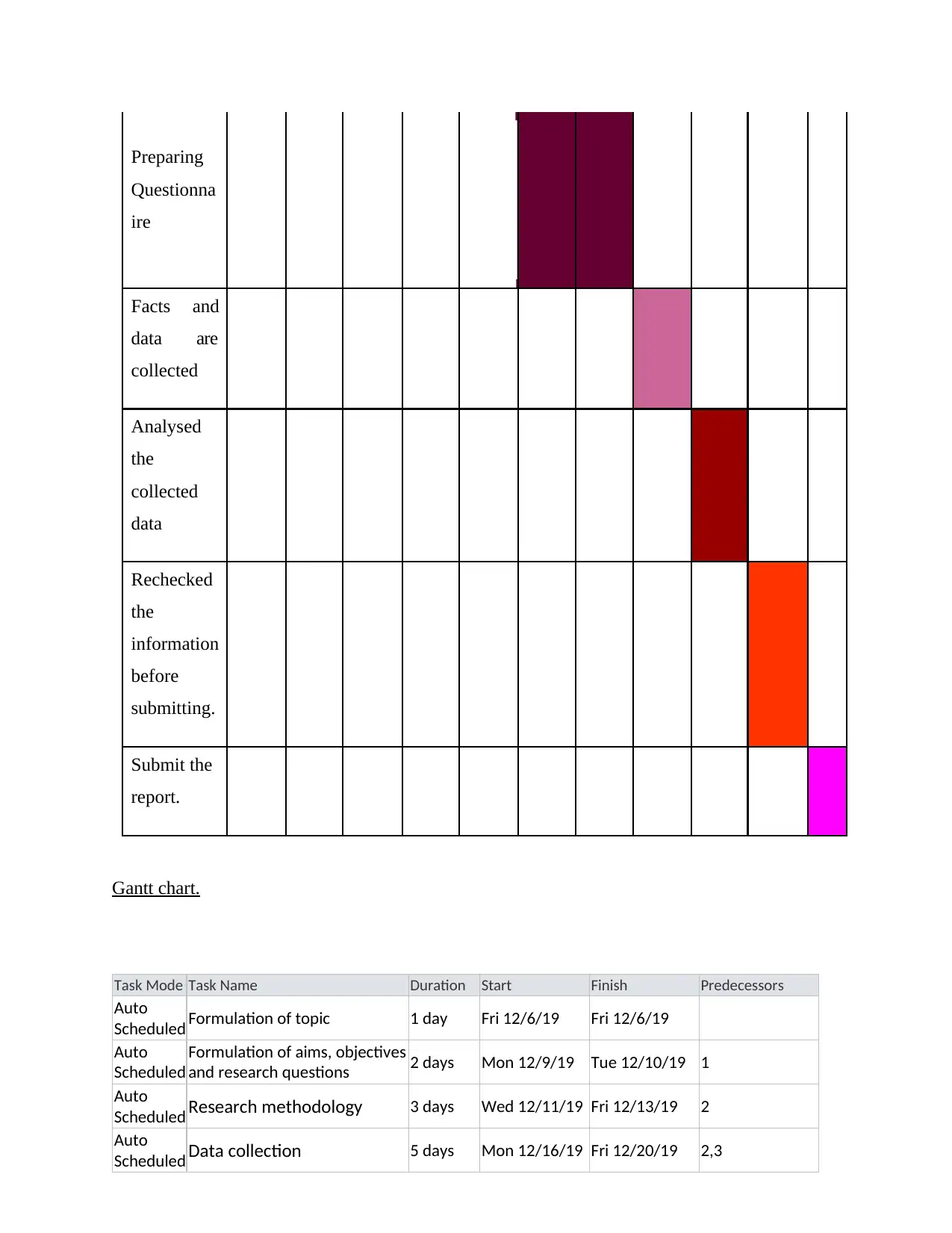
Preparing
Questionna
ire
Facts and
data are
collected
Analysed
the
collected
data
Rechecked
the
information
before
submitting.
Submit the
report.
Gantt chart.
Task Mode Task Name Duration Start Finish Predecessors
Auto
Scheduled Formulation of topic 1 day Fri 12/6/19 Fri 12/6/19
Auto
Scheduled
Formulation of aims, objectives
and research questions 2 days Mon 12/9/19 Tue 12/10/19 1
Auto
Scheduled Research methodology 3 days Wed 12/11/19 Fri 12/13/19 2
Auto
Scheduled Data collection 5 days Mon 12/16/19 Fri 12/20/19 2,3
Questionna
ire
Facts and
data are
collected
Analysed
the
collected
data
Rechecked
the
information
before
submitting.
Submit the
report.
Gantt chart.
Task Mode Task Name Duration Start Finish Predecessors
Auto
Scheduled Formulation of topic 1 day Fri 12/6/19 Fri 12/6/19
Auto
Scheduled
Formulation of aims, objectives
and research questions 2 days Mon 12/9/19 Tue 12/10/19 1
Auto
Scheduled Research methodology 3 days Wed 12/11/19 Fri 12/13/19 2
Auto
Scheduled Data collection 5 days Mon 12/16/19 Fri 12/20/19 2,3
⊘ This is a preview!⊘
Do you want full access?
Subscribe today to unlock all pages.

Trusted by 1+ million students worldwide
1 out of 39
Related Documents
Your All-in-One AI-Powered Toolkit for Academic Success.
+13062052269
info@desklib.com
Available 24*7 on WhatsApp / Email
![[object Object]](/_next/static/media/star-bottom.7253800d.svg)
Unlock your academic potential
Copyright © 2020–2025 A2Z Services. All Rights Reserved. Developed and managed by ZUCOL.





